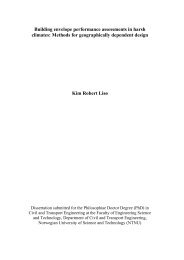Diagnosis and FTC by Prof. Blanke [pdf] - NTNU
Diagnosis and FTC by Prof. Blanke [pdf] - NTNU
Diagnosis and FTC by Prof. Blanke [pdf] - NTNU
You also want an ePaper? Increase the reach of your titles
YUMPU automatically turns print PDFs into web optimized ePapers that Google loves.
25<br />
26<br />
Properties of possible architectures<br />
A behaviour is the relation between variables<br />
(input <strong>and</strong> output) of a function block:<br />
c 1: g1( u, y)<br />
= 0<br />
3<br />
example 1: y( t) − 2 u( t) u( t)<br />
= 0<br />
⎧dx()<br />
t<br />
⎪ =− 2 xt ( ) + 4 ut ( ); x(0) = xo<br />
example 2: ⎨ dt<br />
⎩<br />
⎪ yt () = xt () −0.01()<br />
ut<br />
The<br />
service offered<br />
<strong>by</strong> a function block is to<br />
provide a behaviour<br />
between input <strong>and</strong> output.<br />
S : g( u , y ) = 0<br />
1 1 1 1<br />
Properties of possible architectures<br />
The behaviour of a system with an<br />
architecture A is SA<br />
With the two examples:<br />
( upper )<br />
S = S ∩S ∩S<br />
A<br />
1 2 3<br />
All components must provide the service<br />
to give the required service from u to y<br />
( )<br />
1 3<br />
( lower ) ( ft )<br />
( d )<br />
SA= S1 ∩ S2 ∪S2 ∩S3<br />
We obtain fault-tolerant behaviour if<br />
( d )<br />
S3<br />
is fail-operational (can work despite any<br />
( ft )<br />
single fault) <strong>and</strong> S1<br />
is fault-tolerant: we obtain<br />
*<br />
g(u,y) 1 1 ≈ g(u1,y 1)<br />
but perhabs degraded<br />
(lower performance)<br />
Mogens <strong>Blanke</strong> – Spring 2006<br />
Mogens <strong>Blanke</strong> – Spring 2006<br />
13


![Diagnosis and FTC by Prof. Blanke [pdf] - NTNU](https://img.yumpu.com/12483948/13/500x640/diagnosis-and-ftc-by-prof-blanke-pdf-ntnu.jpg)













